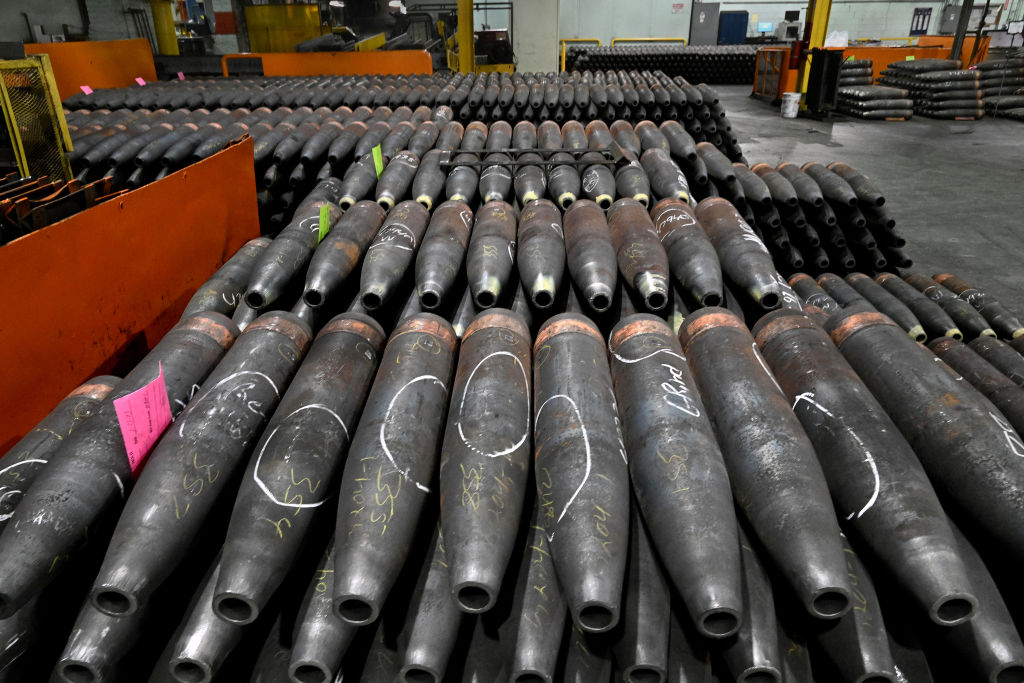
Ukraine’s allies are growing increasingly concerned about the country’s dwindling ammunition supply and production shortfalls as fighting against Russia intensifies in Bakhmut. For this reason, the U.S.-led Ukraine Defense Contact Group—which includes around 50 countries—hosted a virtual meeting Wednesday to discuss how to make sure Ukraine’s military gets enough of the ammunition it needs.
Western officials have been sounding the alarm for months. In February, NATO Secretary General Jens Stoltenberg said, “The current rate of Ukraine’s ammunition expenditure is many times higher than our current rate of production. This puts our defense industries under strain.”
To date, the U.S. has supplied Ukraine with more than 1 million 155-millimeter shells, the NATO-standard artillery shell. The U.S. army is planning to boost the current production rate of about 14,000 155-millimeter howitzer shells per month to 20,000 by this spring and up to 90,000 by 2025.
For their part, E.U. countries have provided Ukraine with about 350,000 155-millimeter shells in total, according to POLITICO.
But these deliveries have come at the price of both the U.S. and Europe’s own ammunition supplies. “They’ve got to work out how much they’re willing to sacrifice their own stocks and defensive ability in order to help Ukraine,” says Trevor Taylor, professor emeritus at Cranfield University in the U.K., who heads a research program on defense and industry at the Royal United Services Institute think tank.
Despite these concerns, Western officials are calling for greater supplies.
“The most important, pressing issue today for the Ukrainian army is to have a continuous flow of ammunition,” E.U. foreign policy chief Josep Borrell said last month. “If we fail on that, really, the result of the war is in danger.”
Borrell said Russian forces fired about 50,000 rounds of artillery each day, compared to about 6,000-7,000 from Ukraine—and that the gap should be closed.
Estonia, which shares a border with Russia, is pushing the E.U. and NATO allies to provide 1 million artillery shells.
More from TIME
The E.U. appears to be closing in on a €2 billion ($2.12 billion) deal to restock ammunition supplies for Ukraine and also refill countries’ stocks, POLITICO reported. Half will be dedicated to partly reimburse countries that are already in a position to donate ammunition from their stockpiles. The other half will be designated for countries to jointly purchase new ammunition to buy at scale, allowing for cheaper overall costs.
But experts tell TIME that the danger for Ukraine is not that they will run out of ammunition but that their supplies will be lowered to an extent that will limit their approach on the battlefield. “Armies don’t run out of ammunition, ammunition supplies get lowered—and as they get lowered, armies have to shoot at higher priority targets and not shoot at lower priority targets,” says Mark F. Cancian, a retired Marine Corps reserves colonel and senior advisor at the Center for Strategic and International Studies.
Strong offensives often require a huge stockpile of ammunition. “In World War I, armies would spend months stockpiling ammunition around a certain area; they would build rail lines, typically, to start to bring in artillery,” says Ian Williams, deputy director of CSIS’s Missile Defense Project.
But experts add that Ukraine should still be able to effectively defend itself. “Holding ground is easier than winning ground,” says Taylor.
Ukraine is currently holding off Russian advances in the eastern city of Bakhmut, which has intensified since January. While Ukraine has expelled Russian forces from Kherson, it is still facing intense shelling from tanks and artillery there. Strikes continue to hit Kharkiv, too.
“The biggest bottleneck right now is production,” says CSIS’s Williams. The defense industry is typically not able to scale up production so rapidly; it is often operating to meet the demands of home governments. NATO’s Stoltenberg has noted that some orders placed today may take two and a half years to arrive.
In the U.S., for example, “private companies aren’t going to produce things unless someone’s going to buy them and military budgets are under strain—no matter how big they get; there’s always competing interests,” says Williams. Many countries would choose to invest in lighter types of forces, drones, intelligence and reconnaissance methods, or missiles, he explains. “We don’t have a Soviet style defense industry where we just keep producing shells, whether we need them or not.”
While tanks, missiles, and fighting vehicles have been key for Ukraine to resist Russian offensives, essential ammunition is just as important, if not more, experts note. “This is very much an attritional war with a fairly static frontline,” Williams says. “That kind of combat tends to be where you have two sides that are increasingly dug in, which becomes a very intensive vacuum for ammunition.”
More Must-Reads from TIME
- Cybersecurity Experts Are Sounding the Alarm on DOGE
- Meet the 2025 Women of the Year
- The Harsh Truth About Disability Inclusion
- Why Do More Young Adults Have Cancer?
- Colman Domingo Leads With Radical Love
- How to Get Better at Doing Things Alone
- Michelle Zauner Stares Down the Darkness
Write to Sanya Mansoor at sanya.mansoor@time.com